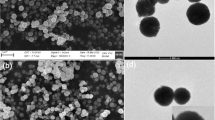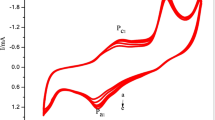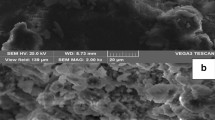Abstract
The presence of Cu2+ in ethanol fuel represents a problem in terms of quality, leading to issues in the engines of automotive vehicles. Thus, this study brings an innovative FeIII-organic framework to develop an electrochemical sensor to detect Cu2+ in ethanolic media. The synthesized metal–organic framework (MOF) was MIL-88b-NH2 and MIL-82, and these materials were characterized using powder X-ray diffraction and infrared spectroscopy. The results showed the successful synthesis of both MOFs with minor synthetic modifications. Subsequently, the modified carbon paste selected to analyze Cu2+ in ethanol fuel was MIL-88b-NH2 based on the results obtained from cyclic voltammetry and electrochemical impedance spectroscopy. Subsequently, square wave anodic stripping voltammetry parameters were optimized using a design of experiments approach. The analytical signal of the electrode exhibited good stability (relative standard deviation = 5.2%). Besides, the correlation coefficient (r) and coefficient of determination (R2) calculated in the calibration curve were 0.9993 and 99.85%, respectively, indicating a good fit of the linear model to the experimental data. The limit of detection obtained from the linear equation was 0.020 µmol L−1. Finally, in the recovery test using spiked samples of ethanol fuel, the obtained values were 83 and 96%, indicating the absence of matrix effects. Our findings demonstrate that the MIL-88b-NH2 modified carbon paste electrode is a suitable sensor for assessing Cu2+ contamination in ethanol fuel under and above the limit permitted by Brazilian legislation.




Similar content being viewed by others
Data availability
The data can be requested on demand.
References
Ding M, Flaig RW, Jiang H-L, Yaghi OM (2019) Carbon capture and conversion using metal–organic frameworks and MOF-based materials. Chem Soc Rev 48:2783–2828. https://doi.org/10.1039/C8CS00829A
Yaghi OM, Li G, Li H (1995) Selective binding and removal of guests in a microporous metal–organic framework. Nature 378:703–706. https://doi.org/10.1038/378703a0
Furukawa H, Cordova KE, O’Keeffe M, Yaghi OM (2013) The chemistry and applications of metal-organic frameworks. Science 341:974–987. https://doi.org/10.1126/science.1230444
Griffin SL, Champness NR (2020) A periodic table of metal-organic frameworks. Coord Chem Rev 414:213295–213315. https://doi.org/10.1016/j.ccr.2020.213295
Xue DX, Wang Q, Bai J (2019) Amide-functionalized metal–organic frameworks: syntheses, structures and improved gas storage and separation properties. Coord Chem Rev 378:2–16. https://doi.org/10.1016/j.ccr.2017.10.026
Kempahanumakkagari S, Vellingiri K, Deep A et al (2018) Metal–organic framework composites as electrocatalysts for electrochemical sensing applications. Coord Chem Rev 357:105–129. https://doi.org/10.1016/j.ccr.2017.11.028
Hersey M, Berger SN, Holmes J et al (2019) Recent developments in carbon sensors for At-source electroanalysis. Anal Chem 91:27–43. https://doi.org/10.1021/acs.analchem.8b05151
Cruz-Navarro JA, Hernandez-Garcia F, Alvarez Romero GA (2020) Novel applications of metal-organic frameworks (MOFs) as redox-active materials for elaboration of carbon-based electrodes with electroanalytical uses. Coord Chem Rev 412:213263–213282. https://doi.org/10.1016/j.ccr.2020.213263
Khakyzadeh V, Sediqi S (2022) The electro-oxidation of primary alcohols via a coral-shaped cobalt metal–organic framework modified graphite electrode in neutral media. Sci Rep 12:8560–8571. https://doi.org/10.1038/s41598-022-12200-w
Kung CW, Li YS, Lee MH et al (2016) In situ growth of porphyrinic metal-organic framework nanocrystals on graphene nanoribbons for the electrocatalytic oxidation of nitrite. J Mater Chem A 4:10673–10682. https://doi.org/10.1039/c6ta02563c
Wang Y, Wu Y, Xie J, Hu X (2013) Metal-organic framework modified carbon paste electrode for lead sensor. Sensors Actuators B Chem 177:1161–1166. https://doi.org/10.1016/j.snb.2012.12.048
Squissato AL, Almeida ES, Silva SG et al (2018) Screen-printed electrodes for quality control of liquid (Bio)fuels. TrAC - Trends Anal Chem 108:210–220. https://doi.org/10.1016/j.trac.2018.08.024
Almeida ES, Richter EM, Munoz RAA (2014) On-site fuel electroanalysis: determination of lead, copper and mercury in fuel bioethanol by anodic stripping voltammetry using screen-printed gold electrodes. Anal Chim Acta 837:38–43. https://doi.org/10.1016/j.aca.2014.05.031
Saciloto TR, Cervini P, Cavalheiro ÉTG (2014) Simultaneous voltammetric determination of Zn(II), Pb(II), Cu(II), and Hg(II) in ethanol fuel using an organofunctionalized modified graphite-polyurethane composite disposable screen-printed device. Electroanalysis 26:2664–2676. https://doi.org/10.1002/elan.201400282
Squissato AL, Lima AF, Almeida ES et al (2017) Eucalyptus pulp as an adsorbent for metal removal from biodiesel. Ind Crops Prod 95:1–5. https://doi.org/10.1016/j.indcrop.2016.10.004
ANP - Agência Nacional do Petróleo (2022) RESOLUÇÃO ANP No 907/2022. https://atosoficiais.com.br/anp/resolucao-n-907-2022-dispoe-sobre-as-especificacoes-do-etanol-combustivel-e-suas-regras-de-comercializacao-em-todo-o-territorio-nacional. Accessed 8 Mar 2023
Belincanta J, Alchorne JA, Teixeira Da Silva M (2016) The Brazilian experience with ethanol fuel: Aspects of production, use, quality and distribution logistics. Brazilian J Chem Eng 33:1091–1102. https://doi.org/10.1590/0104-6632.20160334s20150088
ANP Como funciona a fiscalização do abastecimento pela ANP. https://www.gov.br/anp/pt-br/canais_atendimento/imprensa/kits-de-imprensa-1/kit-imprensa-anp-fiscalizacao.pdf. Accessed 8 Mar 2023
ASSOCIAÇÃO BRASILEIRA DE NORMAS TÉCNICAS (2020) NBR 11331: Ethyl alcohol - determination of iron and cooper content - flame atomic absorption spectrometric method. Rio de Janeiro
Bauer S, Serre C, Devic T et al (2008) High-throughput assisted rationalization of the formation of metal organic frameworks in the iron(III) aminoterephthalate solvothermal system. Inorg Chem 47:7568–7576. https://doi.org/10.1021/ic800538r
Sanselme M, Grenèche J-M, Riou-Cavellec M, Férey G (2004) The first ferric carboxylate with a three-dimensional hydrid open-framework (MIL-82): its synthesis, structure, magnetic behavior and study of its dehydration by Mössbauer spectroscopy. Solid State Sci 6:853–858. https://doi.org/10.1016/j.solidstatesciences.2004.04.001
Fukuda IM, Pinto CFF, Moreira CDS et al (2018) Design of experiments (DoE) applied to pharmaceutical and analytical quality by design (QbD). Brazilian J Pharm Sci 54:1–16. https://doi.org/10.1590/s2175-97902018000001006
Nakamoto K (1986) Infrared and Raman spectra of inorganic and coordination compounds, 4th edn. John Wiley & Sons
Deacon G, Phillips R (1980) Relationships between the carbon-oxygen stretching frequencies of carboxylate complexes and the type of carboxylate coordination. Coord Chem Rev 33:227–250. https://doi.org/10.1016/S0010-8545(00)80455-5
Jenkins R, Snyder RL (1996) Introduction to X-ray powder diffractometry. John Wiley & Sons Inc, Hoboken, NJ, USA
Li Y, Xia T, Zhang J et al (2019) A manganese-based metal-organic framework electrochemical sensor for highly sensitive cadmium ions detection. J Solid State Chem 275:38–42. https://doi.org/10.1016/j.jssc.2019.03.051
Wang Y, Wang L, Huang W et al (2017) A metal–organic framework and conducting polymer based electrochemical sensor for high performance cadmium ion detection. J Mater Chem A 5:8385–8393. https://doi.org/10.1039/C7TA01066D
Uygun ZO, Ertuğrul Uygun HD (2014) A short footnote: circuit design for faradaic impedimetric sensors and biosensors. Sensors Actuators B Chem 202:448–453. https://doi.org/10.1016/j.snb.2014.05.029
Marrubini G, Dugheri S, Cappelli G et al (2020) Experimental designs for solid-phase microextraction method development in bioanalysis: a review. Anal Chim Acta 1119:77–100. https://doi.org/10.1016/j.aca.2020.04.012
Silva LRG, Rodrigues JGA, de Vasconcellos MLS et al (2022) Portable and simple electroanalytical procedure for simultaneous detection of dipyrone and norfloxacin with disposable commercial electrodes in water and organic fertilizers. Ionics (Kiel) 28:4833–4841. https://doi.org/10.1007/s11581-022-04689-y
INMETRO (2016) Orientação sobre validação de métodos analíticos. http://www.inmetro.gov.br/Sidoq/Arquivos/Cgcre/DOQ/DOQ-Cgcre-8_05.pdf. Accessed 10 Mar 2023
Pournara AD, Margariti A, Tarlas GD et al (2019) A Ca2+ MOF combining highly efficient sorption and capability for voltammetric determination of heavy metal ions in aqueous media. J Mater Chem A 7:15432–15443. https://doi.org/10.1039/C9TA03337H
Jin J-C, Wu J, Yang G-P et al (2016) A microporous anionic metal–organic framework for a highly selective and sensitive electrochemical sensor of Cu2+ ions. Chem Commun 52:8475–8478. https://doi.org/10.1039/C6CC03063G
Niu B, Li X, Xia W et al (2022) Ag@Ni3(BTC)2 microspheres showing high electrochemical activity and their application as supercapacitors and electrochemical sensors. Synth Met 287:117073. https://doi.org/10.1016/j.synthmet.2022.117073
Theerthagiri S, Rajkannu P, Senthil Kumar P et al (2022) Electrochemical sensing of copper(II) ion in water using bi-metal oxide framework modified glassy carbon electrode. Food Chem Toxicol 167:113313. https://doi.org/10.1016/j.fct.2022.113313
Ehzari H, Amiri M, Safari M, Samimi M (2022) Zn-based metal-organic frameworks and p-aminobenzoic acid for electrochemical sensing of copper ions in milk and milk powder samples. Int J Environ Anal Chem 102:4364–4377. https://doi.org/10.1080/03067319.2020.1784410
Wan J, Shen Y, Xu L et al (2021) Ferrocene-functionalized Ni(II)-based metal-organic framework as electrochemical sensing interface for ratiometric analysis of Cu2+, Pb2+ and Cd2+. J Electroanal Chem 895:115374. https://doi.org/10.1016/j.jelechem.2021.115374
Acknowledgements
The authors would like to thank Laboratório Multiusuário de Instrumentação – LabMInst (LabPetro-UFES, Brazil) for performing FTIR, Fluorescence measurements (Technical Cooperation Agreements No. 0050.0022844.06.4).
The authors would like to thank Laboratório Multiusuários de difração de raios X (LabPetro-UFES, Brazil) for performing PXRD measurement (Technical Cooperation Agreements FAPES No. 162/2020).
Funding
The authors, R. Fonseca and G. Santos, were funded with a scholarship from the Coordination of Superior Level Staff Improvement and the Brazilian National Council for Scientific and Technological Development (No. 158768/2019–1), respectively.
Author information
Authors and Affiliations
Contributions
All authors contributed to the study’s conception and design. Material preparation, data collection, and analysis were performed by R. R. F. F., G. F. S. S., and J. G. A. R. The first draft of the manuscript was written by R. R. F. F., and all authors commented on previous versions of the manuscript. R. Q. F. and P. P. L. read and approved the final manuscript.
Corresponding author
Ethics declarations
Ethical approval
This research did not involve human or animal samples.
Competing interests
The authors declare no competing interests.
Additional information
Publisher's Note
Springer Nature remains neutral with regard to jurisdictional claims in published maps and institutional affiliations.
Supplementary Information
Below is the link to the electronic supplementary material.
Rights and permissions
Springer Nature or its licensor (e.g. a society or other partner) holds exclusive rights to this article under a publishing agreement with the author(s) or other rightsholder(s); author self-archiving of the accepted manuscript version of this article is solely governed by the terms of such publishing agreement and applicable law.
About this article
Cite this article
Fonseca, R.R.F.d., Santos, G.F.S.d., Rodrigues, J.G.A. et al. A functional FeIII-based NH2-MOF as an electrochemical sensor for Cu2+ detection in ethanol fuel. Ionics 30, 2397–2407 (2024). https://doi.org/10.1007/s11581-024-05425-4
Received:
Revised:
Accepted:
Published:
Issue Date:
DOI: https://doi.org/10.1007/s11581-024-05425-4




